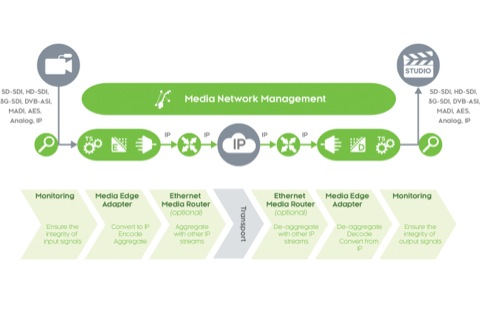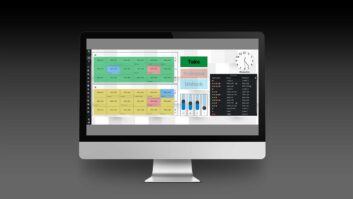
By Geir Bryn-Jensen, CEO, Nevion
As an industry, professional broadcasting accepted IP in the contribution realm with more than a little dose of skepticism. For all of IP’s benefits and its impressive developments in the content distribution area, many have continued to doubt IP’s ability to handle the contribution and production sides of the business. Some point to the enormous bandwidth needed to carry high-quality live content as the key reason for doubt around IP, alongside the inherent ‘best-effort’ principle underlying the technology that seems incompatible with the need for realtime, no-downtime content transport. These objections were valid – yesterday. Massive affordable bandwidth is now widely available and technology exists to overcome other limitations. IP infrastructure, its associated technologies and individual solutions have matured. Each day seems to bring easier and less costly ways to migrate to IP and enjoy its economies of scale, built-in flexibility, lower network operating and capital costs, greater flexibility and ability to push more content/increased bandwidth.
Like any other industry, the broadcasting business is under pressure to find ways to reduce costs and make better use of resources—both people and equipment—while also becoming faster and more nimble in the production of live content. But perhaps even more significant is creating a reliable media network that can best serve broadcasters now and into the future.
IP is no longer just a viable transport protocol but a way to revolutionalise the way content of all types is transferred. More channels, local content insertion and the proliferation of second screens means digital networks can take advantage of new ways to monetise content. Particularly for live events, the ability to reach end users not just through television but also on a number of connected devices has become critical to success in the coming years. People are no longer consuming media in front of a TV screen – think of the thousands of people who are involved in live sporting events (Olympics or World Cups) and festivals through social media or other digital channels. This is a content-hungry audience ready to be connected with.
IP and live content: An ideal match
Live content (video, audio or associated data) is both the most valuable and the most challenging asset to protect and manage. For broadcasters, live content draws in viewers and audiences and therefore advertisers which creates critical revenue opportunities. Yet reliably handling large volumes of high-quality live content that must be transported over long distances in realtime presents difficulties.
IP’s inherent properties make it a natural fit for live media broadcast. Connectionless transport, flexibility, economies of scale, and increased bandwidth for greater content transport – are ideally suited to today’s live environment where set up and tear down of services on demand is required to meet constantly changing needs. IP-based infrastructures also provide more efficient use of network resources, and decreased operating and capital costs, a boon to any production.
The underlying key is the any-to-any connectivity that IP provides. Adding or taking down connections has always been quick and easy for those with the technical expertise. Now, new integrated, end-to-end and highly nimble IP systems make it possible for non-experts to do the same, with just a few clicks on an open interface. Such systems consist of built-in service provisioning, connection management, service analytics, network inventory, and fault-, configuration- and performance-management functions.
IP networks are also inherently resilient; the network will always reroute around any link or router failure, assuming the network has been properly designed with resilient nodes and links. Historically though, the default recovery speed of an IP network is too slow for professional broadcasting, where every dropped frame is an issue. However, systems and architecture specifically designed to handle realtime content transport now provide the resilience and recovery speeds to the levels expected by broadcasters. This allows IP networks to survive multiple link and node failures, which is not always achieved with path-protected networking technologies.
Easier, faster remote production
With IP infrastructure, remote live production becomes faster, easier and less expensive. Software- and hardware-driven IP systems speed workflows by simplifying the set up, management and monitoring of IP infrastructure and bring substantial cost savings, as well as increased quality, flexibility, and scalability.
Vastly improved content flow between people and locations also brings benefits to the entire broadcast chain. Once broadcast services are managed within the IP domain, broadcasters can transform the production, post-production, contribution, and distribution of core assets. The ability to share these assets quickly and efficiently on a shared IP network can unleash unprecedented collaboration, efficiency and agility. It can also dramatically decrease time to market for new services, including HD video and content delivery over multiple platforms. Today, producers sitting in a London corporate office can access live streaming content in an OB van parked outside of a stadium in the US. IP is everywhere; its ubiquitous connections make remote production far simpler, more accessible and less costly.
The best modern IP networks feature a broadcast-centric overlay of systems and architecture. Combine this with high signal quality, extremely low latency, robust protection, and comprehensive monitoring twinned with cheaper and more efficient live remote broadcasts and IP is the logical choice. With the right solutions, reliable, resilient, scalable and low latency IP networks compatible with existing network standards and equipment are now attainable.
The case for education
If there’s any moral to the story of rising IP adoption, it’s that broadcasters must have basic knowledge of how IP networks function, especially when securing bandwidth through service provider networks. A knowledge gap can become all too apparent when engineers and equipment operators well versed in established point-to-point systems don’t speak the same language as IT experts.
Broadcasters must understand how their needs fit with established IP service parameters and translate those needs into concrete SLAs to ensure the continued high-quality service required by contribution video transport. The business reality is that if you’re not using the bandwidth provided by your service provider, someone else probably is. Re-selling unused bandwidth is simply part of service providers’ business models. At the same time, careful monitoring and management will ensure that IP networks provide the same level of guaranteed bandwidth that other point-to-point connectivity provides, as well as the new benefits it’s capable of providing. It all starts with being educated and knowing what to look for and how to get it.
Convergence
IP’s flexibility to adapt to market demands, efficient use of bandwidth, reduced operating expense, ease of service, and application integration also make it the best converged network technology. Capable of meeting the requirements of both real-time and file-based video services, not only in secondary distribution networks such as IPTV over residential broadband (for example, DSL and cable), but also increasingly for primary distribution and contribution networks, it’s not hard to see why IP’s march toward dominance seems inevitable.







